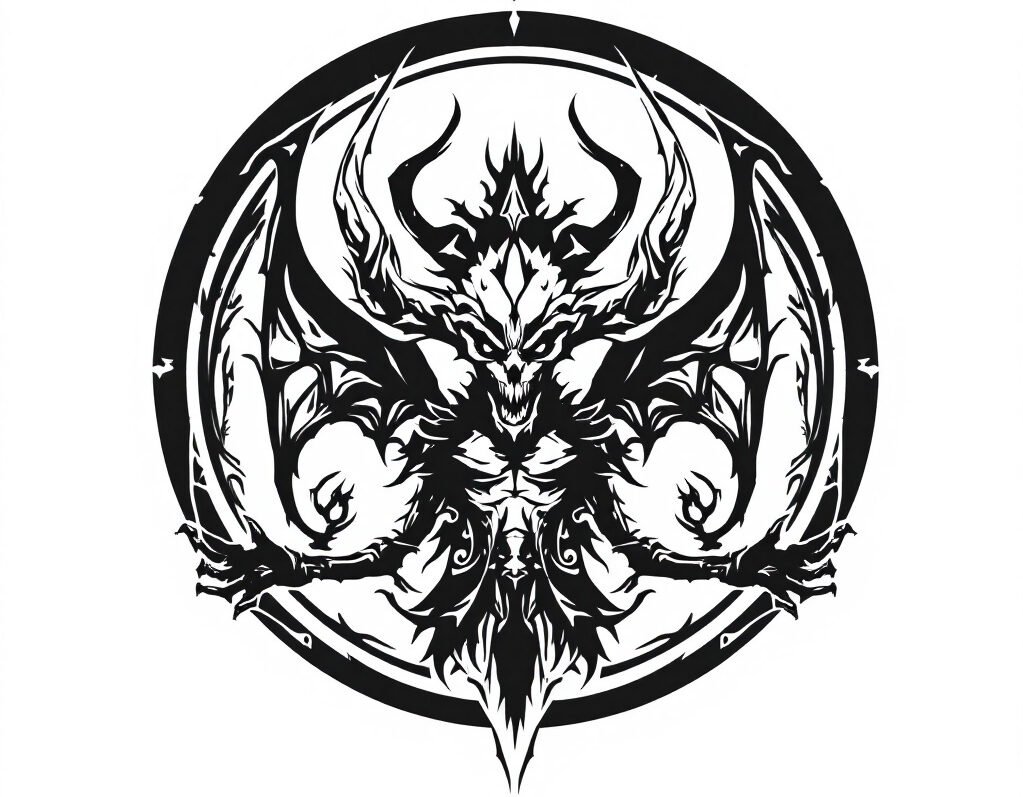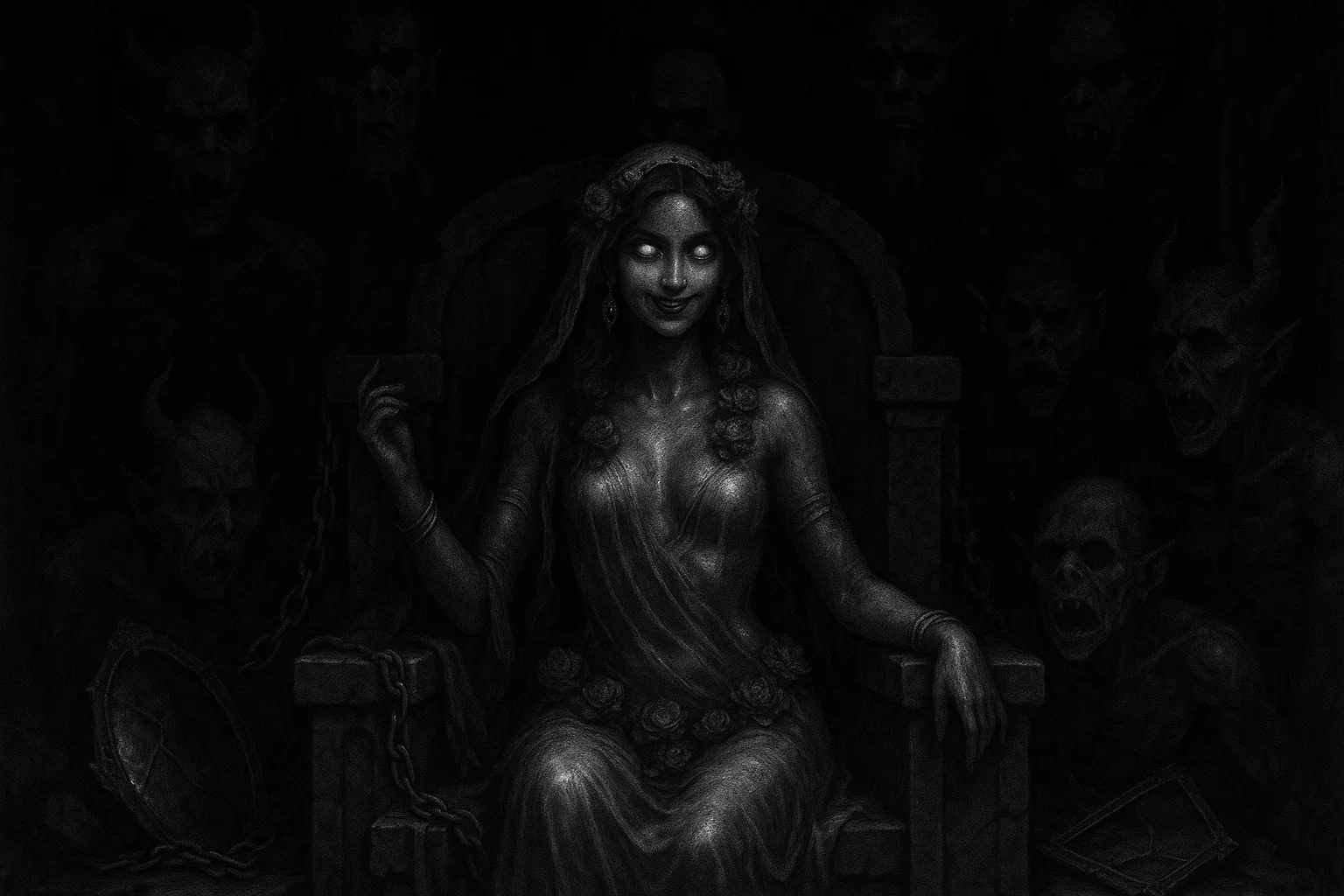Rāga, one of the three daughters of Mara—the chief demon in Buddhist tales—stands as a vivid symbol of attachment and desire. In Buddhist stories, she joins her sisters, Taṇhā (craving) and Arati (aversion), to tempt spiritual seekers away from enlightenment.
As a force of passion, Rāga whispers of sensual delights, pulling people back into the cycle of birth and death. Her role highlights how unchecked emotions block the path to freedom from suffering. These figures appear in early texts, such as the Samyutta Nikaya, where they attempt — and fail — to sway the Buddha.
Rāga’s story ties closely to Mara’s efforts to halt the Buddha’s awakening under the Bodhi tree. Unlike abstract concepts in later teachings, she acts as a living challenge, dressed in beauty and charm.
Summary
Key Takeaways
| Attribute | Details |
|---|---|
| Names | Rāga (primary); Ragā, Lo kien (Chinese transliteration); Rati (variant in some Sanskrit texts like Lalitavistara) |
| Title | None |
| Region | India (origin); spreads to Tibet, China, Southeast Asia via Buddhist traditions |
| Type | Buddhist demon; personification of emotion |
| Gender | Female |
| Realm | Desire realm (Kāmadhātu) |
| Obstacle/Threat | Attachment and lust; tempts with sensual pleasures to block enlightenment |
| Associated Figures | Mara (father); Taṇhā and Arati (sisters); Buddha (adversary) |
| Weapon/Item | None; uses seductive beauty and illusions |
| Weaknesses | Mindfulness and insight; overcome by recognizing emotions as empty |
| Associated Deity/Figure | Buddha (counters through wisdom and detachment) |
| Pantheon | Buddhist (Theravada, Mahayana, Vajrayana); influences from Hindu traditions |
| Primary Sources | Samyutta Nikaya (SN 4.25); Suttanipata (Sn 835); Mahaprajnaparamitāśāstra (chapter XXIV) |
“Rāga” Meaning
The name “Rāga” comes from ancient Sanskrit and Pali words, where it means “color,” “hue,” or “dye.” Over time, it shifted to describe deep passion or attachment — like a stain that colors the mind and won’t wash away.
In Buddhist texts, this root ties to how emotions “dye” our thoughts, making us cling to fleeting joys. Linguists trace it to the Indo-European reg-, linked to words for “red” or “to dye,” which hints at an intense, fiery desire.
Early Pali Canon texts, such as the Dhammapada, portray Rāga as a poison that fuels suffering, much like greed in daily life.
As Buddhism spread, the term evolved across regions. In India, it stayed close to Sanskrit roots, meaning lust as a barrier to nirvana. Tibetan texts call it ‘dod chags, blending “want” and “stick,” to stress clinging.
Chinese translations, such as tan (greed), adapt it for local ears, while Southeast Asian Theravada retains the Pali form. In Mahayana works, such as the Lalitavistara, variants like Rati appear, softening it to “delight” while keeping the core idea of sensual attraction.
Historians note Rāga’s roots in pre-Buddhist ideas, where gods like Kama were associated with stirring love. But Buddhists flipped it—no longer a playful force, but a demon’s tool.
In The Princeton Dictionary of Buddhism, she is defined as one of the three poisons (alongside hate and delusion), a constant foe in meditation. On the other hand, the Encyclopedia of Buddhism associates her name with the concept of kleśas (afflictions), illustrating how it evolves from a word to a warning.
By Vajrayana times, Rāga even joins tantric rites, having been transformed from an enemy to an ally in rituals. Across 2,500 years, the name stays simple, yet its weight grows: a reminder that passion dyes the soul until insight bleaches it clean.
How to Pronounce “Rāga” in English
Say it as “RAH-guh.” The first syllable rhymes with “car,” with a soft roll on the “r” if you like. The “ā” is long, like in “father,” and “ga” ends quickly, like in “gut.”
In Tibetan, it’s closer to “doh-chahg,” but English retains the straightforward translation.
What Does Rāga Look Like?
Early Buddhist art and texts paint Rāga as a stunning young woman, her form a weapon of allure. She arrives with flowing hair, bright eyes, and skin like polished gold—all meant to stir the heart.
In the Samyutta Nikaya, she and her sisters “glitter with beauty,” dressed in sheer silks that hint at curves and grace. Unlike “classic” demonic entities, the three daughters of Mara don’t have horns or claws. Rāga’s pure temptation, tall and lithe, with a smile that promises endless nights of joy.
Sculptures from Amaravati (2nd century) depict her dancing near the Buddha’s throne, her hips swaying, and her arms raised in playful poses. Her eyes lock on the seeker, full of warmth and want.
However, depictions may vary from one region to another. Or from one story to another. For instance, in Indian Theravada reliefs (such as those at Sanchi) Rāga appears as a maiden in a group, her body half-veiled, surrounded by lotus blooms that nod to the false purity of desire.
Tibetan Thangka paintings add a tantric flair. Here, she is often depicted as white or red, with four arms holding jewels and mirrors—symbols of vanity and radiance. Here, as a Ḍākinī in mandalas like the Herukamaṇḍala, she shifts from foe to fierce guide, her face fierce yet fair, adorned with bone ornaments.
Chinese scrolls, influenced by Mahayana, soften her: elegant robes, fan in hand, evoking courtly charm from the Lotus Sutra era.
You may also enjoy:
Who Was Mahishasura, the Buffalo Demon Slain by Goddess Durga?
October 3, 2025
Agubanba: The Ash-Born Demon of Japanese Folklore
October 23, 2025
Mahakala: The Dark Guardian Who Consumes Evil
October 16, 2025
Who Is Abaddon, the Demon of the Abyss, in the Bible?
September 29, 2025
Who Is Adrammelech in Demonology and the Bible?
October 1, 2025
Who Are the Yaksha, and Why Did Buddhists Fear Their Wrath?
October 20, 2025
Origins
Rāga is an entity with deep historical roots in ancient Indian lore, recognized primarily as one of Mara’s daughters. She is frequently referenced in narratives that explore themes of temptation and seduction.
Her earliest mention in the Pali Canon (dating back to approximately the 5th century BCE) presents her as a personification of passion within the context of the Buddha’s spiritual journey.
In the Samyutta Nikaya, she, alongside her sisters, confronts Siddhartha under the Bodhi tree—not merely as apparitions but as authentic tests of resolve.
Early Buddhist monks, in their compilation of oral traditions, drew upon Vedic hymns, where the figure of Kama, the Hindu god of love, resonates in her alluring nature. However, Buddhism nuances this portrayal: Rāga is not depicted as a figure of divine playfulness but rather as a chain forged in the fires of craving.
Her narrative reaches a pivotal moment on the night of the Buddha’s enlightenment, where Mara, the lord of illusion, deploys different forces against Siddhartha yet fails.
In his desperation, he summons his daughters: Taṇhā (embodying thirst), Arati (representing distress), and Rāga (adorned in resplendent beauty). They encircle the seated prince, their voices graceful and persuasive, inviting him to forsake his quest for shadows in favor of immediate pleasures.
However, Siddhartha remains unmoved, his mind representing a serene pond that reflects their presence as mere ephemeral dreams.
Texts such as the Suttanipata further develop this theme, illustrating her transformation into many alluring maidens. Yet, wisdom ultimately pierces through their illusions like dawn dispersing the stars.
Over the centuries, Rāga’s importance evolved, particularly within the Mahayana tradition. The Lalitavistara Sutra (dated to the 1st century CE) venerates her as Rati, integrating her into heroic biographies where she represents the complexities of illusion.
By the 2nd century, Nagarjuna’s Mahaprajnaparamitāśāstra characterizes her as Lo kien—a malevolent figure intended to mislead the Bodhisattva.
Similarly, Vajrayana texts, such as the Cakrasaṃvaratantra, transform Rāga into a tantric ally, channeling her passion towards experiences of bliss.
Regional Variations
Rāga shifts form across Buddhist lands, shaped by local tales and art. In Theravada strongholds like Sri Lanka, she’s a sly maiden in murals, her role fixed as tempter. Mahayana Tibet transforms her into a tantric dancer, fierce yet freeing. These tweaks keep her fresh, a chameleon of craving.
| Region/Tradition | Appearance | Role |
|---|---|---|
| Theravada India/Sri Lanka | Tall, golden-skinned beauty with flowing hair and silks; dances gracefully near Bodhi tree | Seductive tempter; fails to sway Buddha, symbolizing lust’s defeat |
| Mahayana China | Elegant court lady in robes, fan or lotus in hand; soft features, veiled allure | Offers worldly joys; tests detachment in sutra stories |
| Vajrayana Tibet | White or red Ḍākinī with four arms, jewels and bones; wild hair, fierce eyes | Tantric guide; harnesses passion for enlightenment rituals |
| Theravada Thailand | Vibrant mural figure with flower crown, jewels; playful pose amid demons | Part of Mara’s army; embodies desire in Jataka retellings |
Buddhist Cosmology
In Buddhist cosmology, Rāga resides in the Kāmadhātu—the Realm of Desire—comprising a vast wheel of six worlds that range from hells to heavens.
Here, beings chase senses, blind to truth. As Mara’s kin, she rules the sensual pull, her whispers keeping souls chained to rebirth. Unlike higher realms of form or no-form, where desire fades, Kāmadhātu thrives on her fire.
She blocks the path to pure lands or nirvana, a guard at samsara’s gate.
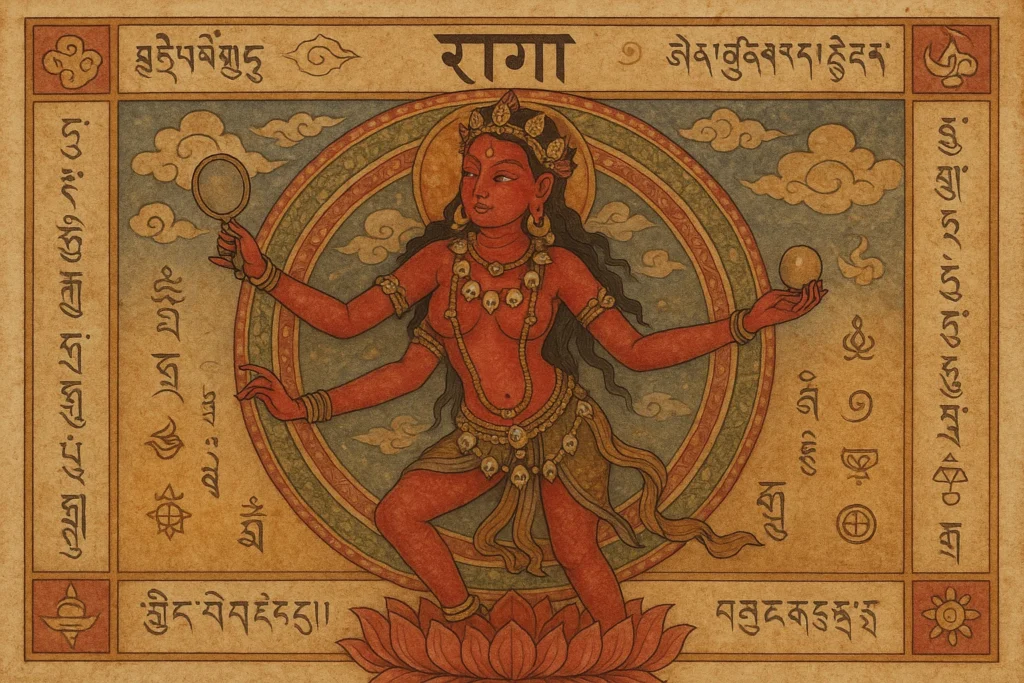
Rāga in the Pali Canon
The Pali Canon casts Rāga as a key player in temptation tales, especially during the Buddha’s enlightenment.
| Source | Quote |
|---|---|
| Samyutta Nikaya 4.25 (Māradhītusutta) | “Then Māra’s daughters—Taṇhā, Arati, and Rāgā—approached the Blessed One and said to him: ‘We serve at your feet, ascetic.’ But the Blessed One paid no attention, as he was liberated in the unsurpassed extinction of acquisitions. ‘Suppose we each manifest ourselves in the form of a hundred maidens.’ Then Māra’s three daughters, each manifesting herself in the form of a hundred maidens, approached the Blessed One and said to him: ‘We serve at your feet, ascetic.’ But the Blessed One paid no attention, as he was liberated in the unsurpassed extinction of acquisitions.” |
| Suttanipata 835 | “They had come to him glittering with beauty — Taṇhā, Arati, and Rāgā — but the Teacher swept them away right there as the wind, a fallen cotton tuft.” |
Rāga in Mahayana Sutras
Rāga appears in Mahayana texts as a persistent tempter, her role amplified in bodhisattva epics.
| Source | Quote |
|---|---|
| Mahaprajnaparamitāśāstra (Chapter XXIV) | “While the Buddha was under the Bodhi tree, king Māra, out of spite (daurmanasya) sent him the three princesses, Lo kien (Ragā), Yue pei (Arati) and K’o ngai (Tṛṣṇā). […] Then the daughters widened their circle, withdrew a little and said to the Bodhisattva: ‘These women are of incomparable beauty and able to please. Why do you keep this seat?’ The Bodhisattva responded: ‘You are impure, dirty and evil-doers.’” |
| Lalitavistara Sutra | “Rati, Arati and Tṛṣṇā […]” (describing the daughters’ assault, with Rati as variant for Rāga). |
Rāga in Chinese or Korean Folklore
Rāga finds little footing in Chinese or Korean folklore as a distinct figure; she’s absorbed into broader demon tales, often as Mara’s shadow.
Jataka-like stories in East Asian collections (such as the Avadana adaptations) recast her temptations in local attire—a sly fox spirit or a court seductress.
You may also enjoy:
Who Is Abalam in Demonology? The Terrifying King That Serves Paimon
September 30, 2025
Who Was Abezethibou, the Fallen Angel Who Opposed Moses?
October 1, 2025
Banasura: The Thousand-Armed Demon King
October 10, 2025
Who Are the Yaksha, and Why Did Buddhists Fear Their Wrath?
October 20, 2025
What Is Qarin and Why Does It Follow Every Human Being?
October 8, 2025
Who Is Agaliarept, the General of Hell Under Lucifer?
October 8, 2025
Powers and Abilities
Rāga wields mid-tier might among Buddhist demons—fiercer than minor yakshas, who guard treasures with tricks, but significantly weaker than Mara’s full storm or Yama’s death grip.
She can’t shatter worlds like cosmic foes, yet her subtle sway rivals illusion-weavers, ensnaring hearts where blades fail. Her strength lies in the mind’s blind spots, outpacing brute forces by turning allies into chains.
Rāga’s powers and abilities include:
- Illusion of Beauty: Crafts visions of ideal lovers or delights, shifting forms — from one maiden to hundreds — to match hidden wants.
- Emotional Stirring: Ignites lust or greed, amplifying cravings until reason fades; a whisper turns friends to rivals.
- Shape-Shifting: Morphs age or guise, young or wise, to slip past guards of will.
- Emotional Binding: Roots attachments, making joys feel eternal; breaks focus in meditation like fog on a path.
- Alliance with Mara: Calls sisters or father’s army, blending passion with fear for layered traps.
- Subtle Influence: Lingers as doubt post-failure, seeding relapse without show.
Rāga Myths, Legends, and Stories
The Assault Under the Bodhi Tree
In the quiet moments just before dawn, Siddhartha sat firmly beneath a sacred fig tree. At the same time, Mara, the embodiment of temptation and evil, watched in defeat. His forces—wild creatures and fierce winds—had crumbled away like dried leaves in the breeze.
Mara, feeling defeated, slumped nearby with a heavy heart, scratching patterns in the dirt with a stick. “He has slipped from my grasp,” he grumbled, his voice heavy with sorrow. “He has gone beyond my reach, and that’s why my grief hurts so deeply.”
From the shadows, the three daughters of Mara emerged: Taṇhā, with eyes as endless as a desert; Arati, her lips curled in disapproval; and Rāga, glowing like the first light of dawn, her presence alluring.
They bowed before Siddhartha, their voices soft and sweet, murmuring, “We kneel at your feet, holy one.” But Siddhartha remained unmoved, his heart calm and still, untouched by their pleas.
Undeterred, the three sisters drew closer. “What if we spread our nets even wider?” Rāga suggested with a playful laugh. “Let’s become a swarm of enchanting girls—each one more captivating than the last.”
In an instant, the air shimmered around them. Suddenly, where there was one, there were many: a crowd of graceful figures in flowing veils, their eyes sparkling like deep, dark pools, reaching out with promises of warmth and affection. “Come, wise one—join us; abandon your lonely throne.”
Yet Siddhartha remained as steady as a rock in a storm. His eyes looked beyond the surface, perceiving not bodies but fleeting shadows—like clouds that vanish in the breeze. No desire stirred within him; no chains could hold him back, for his understanding had set him free. The temptations swayed and then faded away like morning mist in the sunlight.
The sisters pulled back in surprise, their forms returning to just three. From a distance, Mara watched silently, his stick still, worry etched on his face. As night gave way to day, the light emerged, shining brighter than any darkness Mara could summon.
This moment, described in the Samyutta Nikaya, represents Rāga’s most daring attempt—her beauty rendered powerless by the truth. She didn’t leave in anger but rather in exhaustion; her unfulfilled passions had turned to sadness, like ashes blown away by the wind.
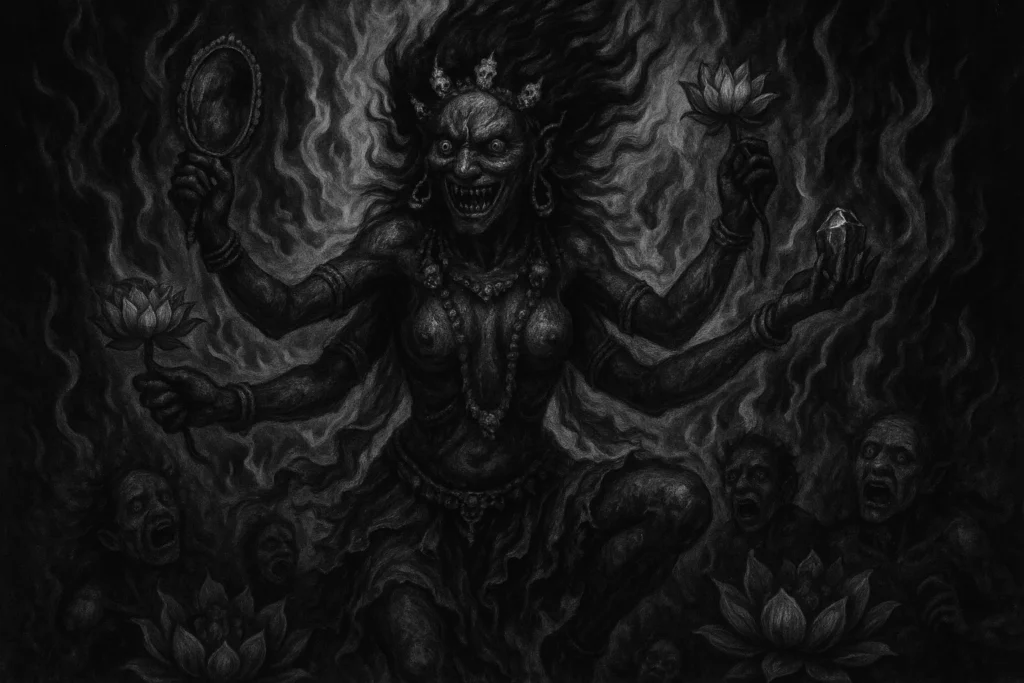
The Dance of Empty Charms
Weeks after awakening, the new Buddha sat peacefully under the Bodhi tree. Although his body was weak from years of struggle, his mind was sharp and clear. News of his great achievement spread across different realms, stirring jealousy among the forces of darkness.
Mara, still hurting from that fateful encounter, called upon his followers once more. “Go,” he urged his three companions with a sly glimmer in his eyes. “Show him the pleasures he has turned away from—the desires he aims to extinguish.”
Rāga took the lead, moving gracefully, her sisters close behind her like reflections of desire and anger. They danced around the Buddha, their veils slipping from their shoulders like the first light of dawn.
“Look at us, teacher,” Rāga said softly, her voice sweet like honey. “We are the joys you left behind—warm embraces for tired souls, lips that melt away the chill of loneliness.” Taṇhā joined in, her hands reaching out as if to pull him closer; Arati frowned, driven by a fierce need to hold on.
The Buddha remained calm, his eyes closed and his breathing steady like a gentle stream. Deep inside, he understood their intentions: they were only fleeting thoughts, illusions dancing on a wall.
“Sisters of desire,” he finally spoke, his voice as gentle as morning dew, “your offerings may satisfy those who are lost in longing. But I have already moved beyond that; I am no longer caught in the web of need. Go back; your dance is meant for those still chained, not for the one who is free.”
Feeling hurt, they pressed on. Rāga twirled more energetically, her form becoming a blur of movement—veils swirling, jewels sparkling, and the scent of jasmine filling the air like a thick fog. Songs filled the space with tales of endless nights where love shines brighter than stars.
But each note felt hollow, each look fell into emptiness. The atmosphere grew heavy; their once-vibrant energy faded to dullness. Exhausted, they retreated, their steps slowing. Mara, hiding in the shadows, clenched his fists—yet another attempt defeated by the light.
From the Suttanipata, this story serves as a lesson: the beauty of desire is fleeting, swept away by the powerful winds of wisdom. Rāga learns that passion cannot warm a heart that has found peace.
Whispers to the Awakened Wanderer
Years later, as the Buddha traveled through deer parks and by rivers, a presence called Rāga lingered like a gentle autumn fog — invisible yet felt in the peaceful moments.
In a grove near Savatthi, during his daily rounds for alms, she appeared softly. There was nothing grand about her; just a young woman by the path, her eyes deep and her voice soothing like an old lullaby.
“Great one,” she said with a sigh, “do you remember the soft cushions of the court? The laughter we shared, the nights filled with freedom? Why wear this rough robe when comfort is within reach?”
The Buddha paused, holding his bowl, a faint smile on his lips like a slim crescent moon. Nearby, the monks froze, sensing the charm in the air. Yet, he saw her clearly: she was not real flesh, but a figment of desire—a trick of the mind, wrapped in the colors of memory.
“Child of craving,” he replied, his voice steady, “the things you offer only tie people up in confusion. I walk a path stripped clean — nothing can ensnare me in emptiness. Fade away now; your song belongs to those who dream, not to those who awaken.”
She persisted, changing her appearance: first as a village bride with baskets of fruit, then as a wise partner. But every disguise fell away under his steady gaze, revealing only her weariness.
With a sigh that echoed through the reeds, she vanished — returning to Mara’s realm, where failures spark new troubles. Her fellow spirits watched from a distance; their game eternal, yet always leading to loss.
This delicate struggle, hinted at in teachings like the Dhammapada and tales of the Jataka, shows Rāga’s cleverness: no loud noises, just the tempting whisper of “what if.”
Rāga vs Other Buddhist Demons
| Demon Name | Associated Obstacle/Role | Origin/Source | Key Traits/Powers |
|---|---|---|---|
| Yama | Judge of the dead; enforces karma | Pali Canon; Abhidhamma | Commands hells; mirror of deeds; unyielding scales |
| Pisacha | Flesh-eater; haunts the hungry | Vinaya Pitaka | Shape-shifts to terrors; feeds on fear; night prowler |
| Yaksha | Nature guardian; tests with riddles | Jataka Tales | Club-wields force; earth-bound; can bless or curse |
| Naga | Serpent spirit; guards treasures | Samyutta Nikaya | Venom blasts; water control; shape to human or snake |
| Kumbhanda | Dwarf demon; spreads disease | Abhidhamma Pitaka | Stunted form; plague breaths; hides in shadows |
| Rakshasa | Man-eater; illusion master | Mahayana Sutras | Cannibal rage; glamours of plenty; night ambushes |
| Preta | Tormented ghost; endless hunger | Petavatthu | Bloated belly, needle throat; craves but can’t eat |
| Asura | Jealous warrior; battles gods | Suttanipata | Titanic strength; envy flames; warlord of depths |
| Gandharva | Celestial musician; lures with song | Digha Nikaya | Melody hypnosis; air flights; dream-weaver |
| Kinnara | Half-bird singer; stirs longing | Jataka Tales | Harmonic calls; wing-borne grace; evokes homesick ache |
| Mahakala | Wrathful protector; devours obstacles | Vajrayana Texts | Multi-armed fury; time eater; guardian turned fierce |
| Hayagriva | Horse-headed fury; cuts ignorance | Mahayana Sutras | Neigh of thunder; blade dances; illusion slayer |
| Simhamukha | Lion-faced; roars doubt away | Vajrayana Tantras | Savage maw; fear devourer; tantric storm |
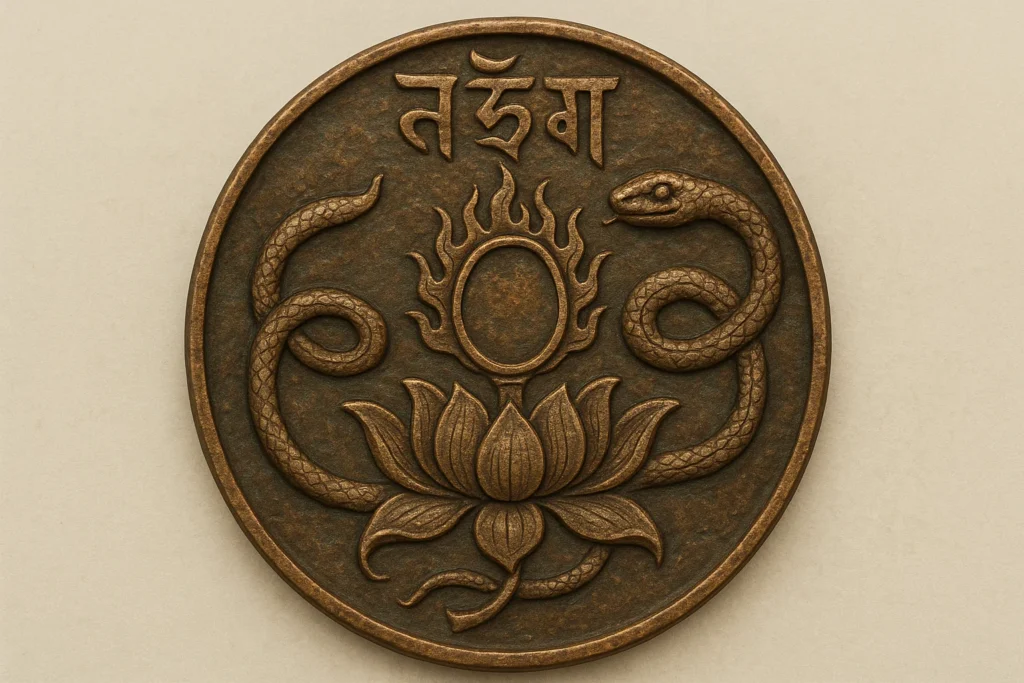
Mystical Correspondences
| Attribute | Details |
|---|---|
| Planet | Venus (fuels desire and bonds) |
| Zodiac Sign | Libra (balance tipped by want) |
| Element | Water (flows unchecked, drowns calm) |
| Direction | East (dawn’s warm lure) |
| Color | Red (passion’s flush; rose for bloom) |
| Number | 3 (one of Mara’s trio daughters) |
| Crystal/Mineral | Rose Quartz (stirs heart’s tie) |
| Metal | Copper (conducts heat of longing) |
| Herb/Plant | Jasmine (scent of night enticements) |
| Animal | Peacock (struts in vain display) |
| Trait/Role | Temptation (binds through sweet chains) |
Mystical Correspondences
Rāga represents a complex mix of emotions and desires, weaving together various symbols that reflect our longing for beauty.
Just as the planet Venus inspires our senses, Rāga draws us close to what we find beautiful. Water symbolizes our thoughts and feelings, often washing away our ability to think clearly if we aren’t careful.
The color red (like the rush of excitement) defines her essence. At the same time, the number 3 represents her connection to her sisters, suggesting a trio of enchanting challenges.
Rose quartz and jasmine flowers represent her delicate but powerful charm — soft to the touch yet captivating. The peacock, with its striking display, embodies pride and allure. Copper, a conductor of energy, signals new beginnings, but it can also lead us into tricky situations.
Rāga’s Items & Symbolism
Rāga doesn’t use conventional weapons like swords or staffs. Instead, her tools are more subtle and symbolic. She handles delicate items (such as silk veils, sparkling jewels that remind one of bright stars, and half-bloomed lotuses glistening with morning dew).
These items represent the nature of illusion: the silk covers yet reveals, the jewels shine beautifully but can feel heavy, and the lotus looks pure but grows from muddy waters.
In Gandhara sculptures, Rāga is often depicted with vibrant, red flowers that symbolize joy but can also burn the soul with desire. Unlike Mara, who sits on a throne, Rāga takes a different approach; she uses a metaphorical mirror that reflects our deepest wants, showing us the chains that hold us back.
Her symbols carry deep meanings: the veil represents how modesty can sometimes hide greed, while the jewels signify how the pursuit of light can blind us to our inner struggles. The lotus symbolizes the duality of beauty—it can lift us or pull us down into the muck.
In certain spiritual practices, Rāga’s Cintāmaṇi gem (which is said to grant wishes) turns desire into something positive—transforming longing into a commitment to wisdom.
You may also enjoy:
Who Is Adrammelech in Demonology and the Bible?
October 1, 2025
Banasura: The Thousand-Armed Demon King
October 10, 2025
Ifrit: Demon of Fire Who Serves Iblis in Islamic Tradition
September 30, 2025
Bali: The Benevolent Asura King of Hindu Mythology
October 10, 2025
Vaisravana: The Golden Guardian King Who Rules the North
October 16, 2025
Who Is Jann in Islamic Mythology and Why Is He Feared?
October 2, 2025
